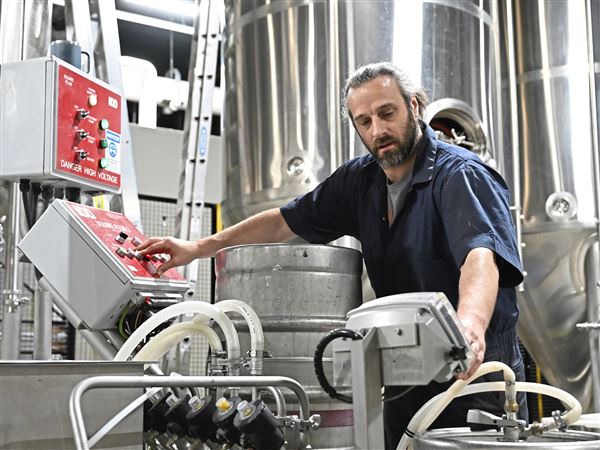At first, the tip seemed like any other.
But the anonymous caller continued to talk, revealing more and more. Pittsburgh police homicide detectives wanted to keep him on the phone.
"They said, there is a substantial reward, and we'll get it to you if you're telling the truth," major crimes Lt. Daniel Herrmann said. "He perked up a lot."
Three hours later, Kenneth Konias Jr., 22, the subject of a nationwide manhunt, was in custody. Police credit the tipster with helping to collar the fugitive, sought in the February killing of a fellow armored car guard in a $2.3 million heist, at a dingy boarding house in Pompano Beach, Fla.
The $100,000 reward offered by Garda Cash Logistics may have loosened the tipster's lips, but it's hard to gauge whether reward money, still a popular tool among investigators, increases the likelihood of solving a case.
Countless variables make reward money difficult for criminologists to study, and law enforcement officials say they've had mixed results with the time-honored tactic. Monetary rewards can mean that investigators get bombarded with erroneous leads; they can cast doubt upon a witness' motives during trial. Disputes can arise over how a bounty is paid out.
But police continue to rely on reward money as a means to draw out wary informants, sometimes those who can break a case.
"It works," said retired Pittsburgh police Cmdr. Ronald Freeman, who oversaw the city's homicide squad from 1987 to 2001. He recalled an instance in which a man called to offer information about a female fugitive's whereabouts -- but only for a price. "Here, it was his own mother. He turned her in for the reward money. He said he was on narcotics and he needed the money for drugs."
But the prospect of a payout doesn't solve every case. Pennsylvania Crime Stoppers, which offers cash rewards of up to $2,000, last year advertised 61 unsolved cases in the media and got just four tips, all leading to arrests. The state's Crime Stoppers also generated 672 unsolicited tips; 16 of those produced an arrest. The organization handles cases from police agencies across the state.
"Any case cleared is a good number," said coordinator Kira Lemmons, adding that 2011 was an uncommonly slow year for the program. She noted that in 2010, the program advertised 92 unsolved crimes that drew 42 tips, resulting in eight arrests. There were 781 unsolicited tips that year, 28 of which helped to secure an arrest.
While the numbers weren't high, the four cases solved by cash-seeking tipsters in 2011 were major crimes, Ms. Lemmons said. One tip cracked a cold case homicide. Another ended a burglary ring.
Leaders of Crime Stoppers USA, which offers up to $1,000 in cash, say their efforts are similarly successful, yielding 620,287 arrests since the national program began in 1976. Still, the promise of anonymity is sometimes more alluring than the reward money, board chairman K. Scott Abrams said. Forty percent of tipsters, he added, don't call back to claim their reward. Of the 20 cases solved in 2011 through Pennsylvania's program, just 12 tipsters claimed their loot, for a combined payout of $13,800.
"A lot of people will call just because they feel they should, not just because of the reward money," said Allegheny County police Detective Robert Opferman, who coordinates the Crime Stoppers program for his department, showcasing unsolved cases on the television news. "I get a lot of feedback when people call in. A lot of times, it doesn't even register that there is a reward. Many tipsters are calling because they don't think what happened was right."
Yet in some cases, "the incentive of a cash reward does not outweigh the potential stigma of being labeled a snitch," said Lt. Andrew Schurman, who heads the county police homicide unit. He pointed to the January 2006 slaying of Christopher Williams, a pizza delivery man who was shot in Braddock after making a delivery.
Detectives identified a suspect and believe at least four or five people saw the shooting. As the investigation slowed, anonymous donors raised the $3,500 reward posted by Crime Stoppers and the victim's employer to $25,000. No witnesses came forward.
"I was hoping the money would be enough to make the difference," said Braddock Mayor John Fetterman, who for years stood beside authorities to announce the growing reward, only to watch it go uncollected. "I don't understand it myself. How often in life are you afforded the opportunity to do the right thing and make $20,000? It would be the best money spent to bring these folks to justice."
Also unsolved is the 2005 shooting of Forest Hills police Officer Matthew Livingstone, who was struck in the chest but survived. Investigators and donors pooled at least $8,250 for information leading police to the gunman.
"We got a lot of tips on that, and they were all in good faith," Lt. Schurman said. "Some just weren't accurate."
Rewards can yield scores of tips, causing detectives to spend countless hours ferreting out the erroneous ones.
"Good people will call in with information they think is helpful, but is not always accurate," the lieutenant said. Rewards, he said, are "a double-edged sword. They're helpful. You never know when you're going to stumble into something important out there that came in as an unsubstantiated tip."
Even the largest and most infamous bounty the United States has ever offered -- $25 million for information leading to the capture of Osama bin Laden -- went unpaid. Officials who posted the reward 10 years before the al-Qaida leader was killed last year have said his death was not the result of an informer but rather electronic surveillance by the government. The CIA and the military could not find an insider willing to give him up.
Rewards can be an important tool but can also cause problems. Eugene O'Donnell, a former New York City police officer and prosecutor who is now a professor of law and police studies at John Jay College of Criminal Justice, said the knowledge that a witness has been paid for information can taint a jury during trial.
A witness' "testimony can be ever so slightly tilted because now [he] becomes the beneficiary of the conviction," he said. "It can color the way a jury views that witness. It can be the grounds for cross-examination and it can be the grounds for reasonable doubt."
Disputes can arise over how the money is doled out. In 2000, ex-convict Philip Jackson, who gave Pittsburgh police information that led to the arrest of a man who was convicted of the 1997 slaying of a Highland Park minister, claimed he was shortchanged by more than $14,000 in reward money. Investigators, who were stymied for more than three years, were able to make a swift arrest after Mr. Jackson told them that Kristopher Heggins had confessed to the killing. Police later learned that Mr. Jackson's version of the shooting didn't coincide with physical evidence. Detectives gathered subsequent leads to strengthen their case after their arrest. Mr. Jackson was paid $6,200 of what he said he was told would be more than $20,000. Police officials said at the time that they kept their end of the bargain.
Mr. Jackson couldn't be located for comment, and Mr. Freeman declined to talk about that case.
Despite the drawbacks, rewards will likely remain a law enforcement strategy.
"It's most obviously a tool you'll lean on in cases where there's a dearth of information," Mr. O'Donnell said. "This can generate visibility and publicity. Just the announcement of a reward can be enough to generate a buzz."
First Published: May 6, 2012, 4:00 a.m.
Updated: May 6, 2012, 4:28 a.m.













